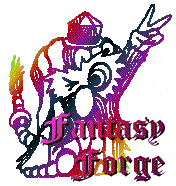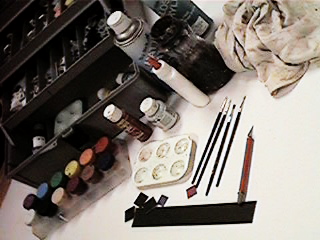 Miniature Painting (tools)
Miniature Painting (tools)
The Tools of the Trade
Most believe that all one needs to paint miniature figures is ...
well, figures and paint. There are several other things necessary,
and one may find it difficult to go and obtain important materials at
the last minute. It is best to have them handy. First one needs the
correct tools for dealing with the miniatures prior to painting.
Proper glues, bases, and resins may be necessary as well. Primer is a
must prior to painting, while a good palette, and quality brushes
along with a large sturdy water container will be required during the
main painting process.

Afterward, optional flocking and a sealant coat are required for
presentation. To make it easier, a list is provided below with some
suggested options for those who have no clue what to get and where to
get it.
List of proper miniature figure working materials:
- a hobby knife: X-acto makes a good brand of light
handled hobby knife. Any hobby or craft store should have such an
item. Wal-Mart and K-mart carry them too.
- a small fine file: as with the knife above, but
Wal-Mart and K-mart would probably carry them in the hardware
department.
- Optionally one may wish to purchase a pin drill. This will
tend to be specialized enough to have to get one from a hobby
shop. Usually such a device would only be used in figure
alteration or in "pinning" together multi part figures.
- a strong fast setting two part epoxy: This can be found
in any hardware section of larger stores like Wal-Mart or K-Mart.
- Water based wood glue: Elmer's school glue works as
well. Such glue is used for three purposes. The first purpose is
to attach card stock bases to figures. The second purpose is to
attach figures to boards or sticks in a row for easier painting of
many similar figures (see #7a). The third purpose is to flock
bases with sand and model grass prior to applying sealant.
- Flat White and Black Spray Paint: Color Creations from
Wal-Mart costs about a dollar per can. Children cannot purchase
Spray paint, and all priming should be done by a responsible
adult. This will be used as primer for various types of figures.
- Clear Spray Paint: Color Creations also makes a good
durable clear gloss. More expensive matte fixatives can be used
instead (check your art supply store or the crafts department of
Wal-Mart), but for durability I like the gloss. The oils from
one's hands while handling will tend to dull the shine quickly
anyway.
- Bases: Most figures either come with or have a base
that is a part of their casting. Plastic slotted bases will either
come with figures or they can be purchased in multi piece packages
from any store that sells miniatures. Good, strong bases can also
be inexpensively cut from mat board scraps. One $5 sheet of 32" x
40" mat can last one practically forever.
- Single figure bases usually come in 25 mm (1") and 20 mm
(3/4") varieties. Generally, plastic bases are necessary for
"slot" cast figures. I use mat for those that merely come with
insufficient flat bottoms or for battlefield miniatures that
need uniform spacing. Do not worry about separate bases for
most RPG personality types. Optionally, Flat strips of wood can
help hold identical figures in a line for assembly line
painting. The wood glue (#4 above) can hold several figures in
a row, and these figures will "pop" off when pried with a
knife. An old, thin piece of molding works well for this
purpose.
- Paint brushes: a size 1 for glue and sizes 1, 0, 00,
and 000 for paint. With brushes, money counts. Cheap brushes may
give trouble. Although many people like synthetic substitutes, I
prefer sable hair. These can be obtained from an art supply store
like Hobby Lobby or Michael's. Actually my personal favorite
brushes are Dick Blick Pure Red Sable Spotters from Dick Blick Art
Materials (1-800-447-8192) item #52400. They run about $3 for a
set of 3 cheap yet well made brushes.
- a palette: This is used for mixing paint. A white piece
of smooth plastic works well. I prefer the commercially produced
six pan white plastic ones from Wal-Mart. They can be found in the
crafts department. Similar surfaces can be found or purchased
almost anywhere. White snap on lids to cottage cheese or sour
cream work well. Some people really like white foam egg cartons.
- a water container: This should be large enough to hold
about a pint of water. I use an old salsa jar. The clear glass
makes it easy to see just how dirty the water is. The general rule
is... "if you cannot see through the water, you need to replace
it."
- a rag: This can be practically anything absorbent. A
sponge, washcloth, or an old (clean) sweat sock work better than
paper towels.
- Acrylic paint: There are various brands on the market.
Generally, miniatures are best painted with matte acrylics
available at most game, hobby, or craft stores. Artist's tube
acrylics usually have an undesirable consistency for miniature
painting.
- Howard Hues makes an excellent miniature paint primarily
sold through game stores. Apple barrel is a bit thinner, but
has a good range of colors at low prices. You can find Apple
Barrel paints at Wal-Mart, Michael's, or Hobby Lobby.
- a box in which to put it all: There is a lot of stuff
generally necessary for miniature figure painting, and the more
organized one is with their paints, the easier they will be to
find and use. I suggest a $5 - $10 fishing tackle box from
Wal-Mart. Art boxes practically identical to a tackle box can run
$25 and up.
Return to top of
page|Next Miniature Page
-->
 Miniature Painting (tools)
Miniature Painting (tools)
 Miniature Painting (tools)
Miniature Painting (tools)
